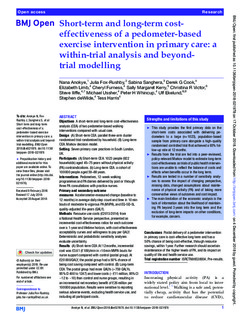| dc.contributor.author | Anokye, Nana | |
| dc.contributor.author | Fox-Rushby, Julia | |
| dc.contributor.author | Sanghera, Sabina | |
| dc.contributor.author | Cook, Derek G. | |
| dc.contributor.author | Limb, Elizabeth S. | |
| dc.contributor.author | Furness, Cheryl | |
| dc.contributor.author | Kerry, Sally M. | |
| dc.contributor.author | Victor, Christina R. | |
| dc.contributor.author | Iliffe, Steve | |
| dc.contributor.author | Ussher, Michael | |
| dc.contributor.author | Whincup, Peter H. | |
| dc.contributor.author | Ekelund, Ulf | |
| dc.contributor.author | DeWilde, Stephen | |
| dc.contributor.author | Harris, Tess | |
| dc.date.accessioned | 2018-12-21T14:32:20Z | |
| dc.date.available | 2018-12-21T14:32:20Z | |
| dc.date.created | 2018-11-16T13:09:40Z | |
| dc.date.issued | 2018 | |
| dc.identifier.citation | BMJ Open. 2018, 8, e021978. | nb_NO |
| dc.identifier.issn | 2044-6055 | |
| dc.identifier.uri | http://hdl.handle.net/11250/2578658 | |
| dc.description.abstract | Objectives: A short-term and long-term cost-effectiveness analysis (CEA) of two pedometer-based walking interventions compared with usual care. Design: (A) Short-term CEA: parallel three-arm cluster randomised trial randomised by household. (B) Long-term CEA: Markov decision model. Setting: Seven primary care practices in South London, UK. Participants: (A) Short-term CEA: 1023 people (922 households) aged 45–75 years without physical activity (PA) contraindications. (b) Long-term CEA: a cohort of 100 000 people aged 59–88 years. Interventions: Pedometers, 12-week walking programmes and PA diaries delivered by post or through three PA consultations with practice nurses. Primary and secondary outcome measures: Accelerometer-measured change (baseline to 12 months) in average daily step count and time in 10 min bouts of moderate to vigorous PA (MVPA), and EQ-5D-5L quality-adjusted life-years (QALY). Methods: Resource use costs (£2013/2014) from a National Health Service perspective, presented as incremental cost-effectiveness ratios for each outcome over a 1-year and lifetime horizon, with cost-effectiveness acceptability curves and willingness to pay per QALY. Deterministic and probabilistic sensitivity analyses evaluate uncertainty. Results: (A) Short-term CEA: At 12 months, incremental cost was £3.61 (£109)/min in ≥10 min MVPA bouts for nurse support compared with control (postal group). At £20 000/QALY, the postal group had a 50% chance of being cost saving compared with control. (B) Long-term CEA: The postal group had more QALYs (+759 QALYs, 95% CI 400 to 1247) and lower costs (−£11 million, 95% CI −12 to −10) than control and nurse groups, resulting in an incremental net monetary benefit of £26 million per 100 000 population. Results were sensitive to reporting serious adverse events, excluding health service use, and including all participant costs. Conclusions: Postal delivery of a pedometer intervention in primary care is cost-effective long term and has a 50% chance of being cost-effective, through resource savings, within 1 year. Further research should ascertain maintenance of the higher levels of PA, and its impact on quality of life and health service use. | nb_NO |
| dc.description.abstract | Short-term and long-term cost-effectiveness of a pedometer-based exercise intervention in primary care: a within-trial analysis and beyond-trial modelling | nb_NO |
| dc.language.iso | eng | nb_NO |
| dc.title | Short-term and long-term cost-effectiveness of a pedometer-based exercise intervention in primary care: a within-trial analysis and beyond-trial modelling | nb_NO |
| dc.type | Journal article | nb_NO |
| dc.type | Peer reviewed | nb_NO |
| dc.description.version | publishedVersion | nb_NO |
| dc.rights.holder | © Author(s) (or their employer(s)) 2018. Re-use permitted under CC BY. Published by BMJ. This is an open access article distributed in accordance with the Creative Commons Attribution 4.0 Unported (CC BY 4.0) license, which permits others to copy, redistribute, remix, transform and build upon this work for any purpose, provided the original work is properly cited, a link to the licence is given, and indication of whether changes were made. See: https://creativecommons.org/licenses/by/4.0/. | nb_NO |
| dc.source.pagenumber | 10 | nb_NO |
| dc.source.volume | 8 | nb_NO |
| dc.source.journal | BMJ Open | nb_NO |
| dc.source.issue | 10 | nb_NO |
| dc.identifier.doi | 10.1136/bmjopen-2018-021978 | |
| dc.identifier.cristin | 1631464 | |
| dc.description.localcode | Seksjon for idrettsmedisinske fag / Department of Sport Medicine | nb_NO |
| cristin.unitcode | 150,34,0,0 | |
| cristin.unitname | Seksjon for idrettsmedisinske fag | |
| cristin.ispublished | true | |
| cristin.fulltext | original | |
| cristin.qualitycode | 1 | |
